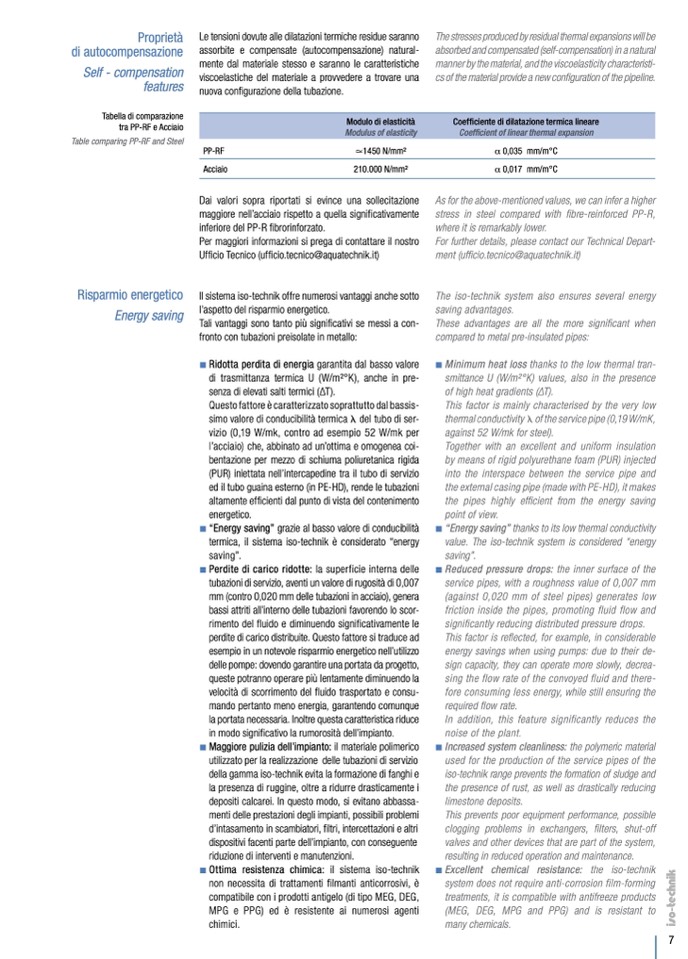
Proprietà
di autocompensazione
Self - compensation
features
Tabella di comparazione
tra PP-RF e Acciaio
Table comparing PP-RF and Steel
Risparmio energetico
Energy saving
Le tensioni dovute alle dilatazioni termiche residue saranno
assorbite e compensate (autocompensazione) natural-
mente dal materiale stesso e saranno le caratteristiche
viscoelastiche del materiale a provvedere a trovare una
nuova configurazione della tubazione.
The stresses produced by residual thermal expansions will be
absorbed and compensated (self-compensation) in a natural
manner by the material, and the viscoelasticity characteristi-
cs of the material provide a new configuration of the pipeline.
α 0,035 mm/m°C
α 0,017 mm/m°C
As for the above-mentioned values, we can infer a higher
stress in steel compared with fibre-reinforced PP-R,
where it is remarkably lower.
For further details, please contact our Technical Depart-
ment (ufficio.tecnico@aquatechnik.it)
The iso-technik system also ensures several energy
saving advantages.
These advantages are all the more significant when
compared to metal pre-insulated pipes:
nMinimumheatlossthankstothelowthermaltran-
smittance U (W/m2°K) values, also in the presence
of high heat gradients (ΔT).
This factor is mainly characterised by the very low
thermal conductivity l of the service pipe (0,19 W/mK,
against 52 W/mk for steel).
Together with an excellent and uniform insulation
by means of rigid polyurethane foam (PUR) injected
into the interspace between the service pipe and
the external casing pipe (made with PE-HD), it makes
the pipes highly efficient from the energy saving
point of view.
n “Energy saving” thanks to its low thermal conductivity
value. The iso-technik system is considered “energy
saving”.
nReduced pressure drops: the inner surface of the
service pipes, with a roughness value of 0,007 mm
(against 0,020 mm of steel pipes) generates low
friction inside the pipes, promoting fluid flow and
significantly reducing distributed pressure drops.
This factor is reflected, for example, in considerable
energy savings when using pumps: due to their de-
sign capacity, they can operate more slowly, decrea-
sing the flow rate of the convoyed fluid and there-
fore consuming less energy, while still ensuring the
required flow rate.
In addition, this feature significantly reduces the
noise of the plant.
n Increased system cleanliness: the polymeric material
used for the production of the service pipes of the
iso-technik range prevents the formation of sludge and
the presence of rust, as well as drastically reducing
limestone deposits.
This prevents poor equipment performance, possible
clogging problems in exchangers, filters, shut-off
valves and other devices that are part of the system,
resulting in reduced operation and maintenance.
n Excellent chemical resistance: the iso-technik
system does not require anti-corrosion film-forming
treatments, it is compatible with antifreeze products
(MEG, DEG, MPG and PPG) and is resistant to
many chemicals.
PP-RF
Acciaio
1450 N/mm2
210.000 N/mm2
Modulo di elasticità
Coefficiente di dilatazione termica lineare
Modulus of elasticity
Coefficient of linear thermal expansion
Dai valori sopra riportati si evince una sollecitazione
maggiore nell’acciaio rispetto a quella significativamente
inferiore del PP-R fibrorinforzato.
Per maggiori informazioni si prega di contattare il nostro
Ufficio Tecnico (ufficio.tecnico@aquatechnik.it)
Il sistema iso-technik offre numerosi vantaggi anche sotto
l’aspetto del risparmio energetico.
Tali vantaggi sono tanto più significativi se messi a con-
fronto con tubazioni preisolate in metallo:
nRidottaperditadienergiagarantitadalbassovalore
di trasmittanza termica U (W/m2°K), anche in pre-
senza di elevati salti termici (ΔT).
Questo fattore è caratterizzato soprattutto dal bassis-
simo valore di conducibilità termica l del tubo di ser-
vizio (0,19 W/mk, contro ad esempio 52 W/mk per
l’acciaio) che, abbinato ad un’ottima e omogenea coi-
bentazione per mezzo di schiuma poliuretanica rigida
(PUR) iniettata nell’intercapedine tra il tubo di servizio
ed il tubo guaina esterno (in PE-HD), rende le tubazioni
altamente efficienti dal punto di vista del contenimento
energetico.
n“Energy saving” grazie al basso valore di conducibilità
termica, il sistema iso-technik è considerato “energy
saving”.
nPerdite di carico ridotte: la superficie interna delle
tubazioni di servizio, aventi un valore di rugosità di 0,007
mm (contro 0,020 mm delle tubazioni in acciaio), genera
bassi attriti all’interno delle tubazioni favorendo lo scor-
rimento del fluido e diminuendo significativamente le
perdite di carico distribuite. Questo fattore si traduce ad
esempio in un notevole risparmio energetico nell’utilizzo
delle pompe: dovendo garantire una portata da progetto,
queste potranno operare più lentamente diminuendo la
velocità di scorrimento del fluido trasportato e consu-
mando pertanto meno energia, garantendo comunque
la portata necessaria. Inoltre questa caratteristica riduce
in modo significativo la rumorosità dell’impianto.
nMaggiore pulizia dell’impianto: il materiale polimerico
utilizzato per la realizzazione delle tubazioni di servizio
della gamma iso-technik evita la formazione di fanghi e
la presenza di ruggine, oltre a ridurre drasticamente i
depositi calcarei. In questo modo, si evitano abbassa-
menti delle prestazioni degli impianti, possibili problemi
d’intasamento in scambiatori, filtri, intercettazioni e altri
dispositivi facenti parte dell’impianto, con conseguente
riduzione di interventi e manutenzioni.
n Ottima resistenza chimica: il sistema iso-technik
non necessita di trattamenti filmanti anticorrosivi, è
compatibile con i prodotti antigelo (di tipo MEG, DEG,
MPG e PPG) ed è resistente ai numerosi agenti
chimici.
7

